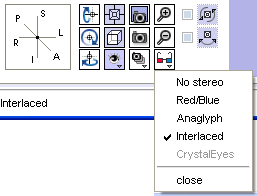Difference between revisions of "Modules:StereoViewing-3.6"
(adding stereo algorithm descriptions) |
|||
| Line 8: | Line 8: | ||
Slicer has the capability to display data in the 3D Viewer stereoscopically in a number of fashions including Red/Blue, Anaglyphic and Interlaced. When you start slicer from the command line, make sure to use the --stereo flag. | Slicer has the capability to display data in the 3D Viewer stereoscopically in a number of fashions including Red/Blue, Anaglyphic and Interlaced. When you start slicer from the command line, make sure to use the --stereo flag. | ||
| + | |||
| + | |||
| + | =Stereo Modes Explained= | ||
| + | |||
| + | The first two algorithms require only 3D glasses, not any special computer hardware configurations. The last two algorithms require special stereo-ready display systems: | ||
| + | |||
| + | '''Red/Blue''' - For use with red/blue glasses commonly available in magazines or on the internet (see http://www.3dglassesdirect.com) The scene is drawn twice (once in each color from the location of each eye). Using the glasses separates the views and recreates perspective. There is some "bleedthrough" of the images to the opposite eye, but users can generally see depth using this algortihm. The drawback to this algorithm is the natural color of objects is lost due to the red & blue rendering. | ||
| + | |||
| + | '''Analglyph''' - This algorithm uses the same glasses as the red/blue algorithm but preserves the natural color of objects. | ||
| + | |||
| + | '''Interlaced''' - In this algorithm the pictures from each eye are intermixed as the picture is rendered from top to bottom. With an ordinary monitor the lines will seem "jaggy" because we are seeing the left and right eye's version of the scene superimposed when using a standard monitor. However a stereo image results when interlaced signals are supported directly by monitors. The Hyundai S465D is one example of a monitor with a vertical interlaced rendering mode. | ||
| + | |||
| + | '''CrystalEyes''' - This stereo mode is named after the famous, legacy glasses now sold by RealD (please see the products at the following website: http://www.reald.com/Content/Crystal-Eyes-5.aspx ). This mode is also called "active stereo". | ||
Revision as of 16:38, 3 June 2010
Home < Modules:StereoViewing-3.6Return to Slicer 3.6 Documentation
Purpose
Slicer has the capability to display data in the 3D Viewer stereoscopically in a number of fashions including Red/Blue, Anaglyphic and Interlaced. When you start slicer from the command line, make sure to use the --stereo flag.
Stereo Modes Explained
The first two algorithms require only 3D glasses, not any special computer hardware configurations. The last two algorithms require special stereo-ready display systems:
Red/Blue - For use with red/blue glasses commonly available in magazines or on the internet (see http://www.3dglassesdirect.com) The scene is drawn twice (once in each color from the location of each eye). Using the glasses separates the views and recreates perspective. There is some "bleedthrough" of the images to the opposite eye, but users can generally see depth using this algortihm. The drawback to this algorithm is the natural color of objects is lost due to the red & blue rendering.
Analglyph - This algorithm uses the same glasses as the red/blue algorithm but preserves the natural color of objects.
Interlaced - In this algorithm the pictures from each eye are intermixed as the picture is rendered from top to bottom. With an ordinary monitor the lines will seem "jaggy" because we are seeing the left and right eye's version of the scene superimposed when using a standard monitor. However a stereo image results when interlaced signals are supported directly by monitors. The Hyundai S465D is one example of a monitor with a vertical interlaced rendering mode.
CrystalEyes - This stereo mode is named after the famous, legacy glasses now sold by RealD (please see the products at the following website: http://www.reald.com/Content/Crystal-Eyes-5.aspx ). This mode is also called "active stereo".
